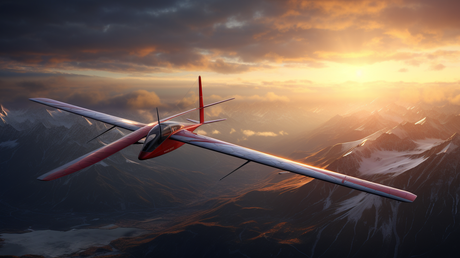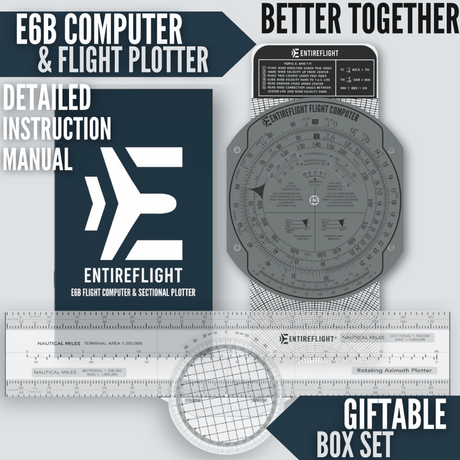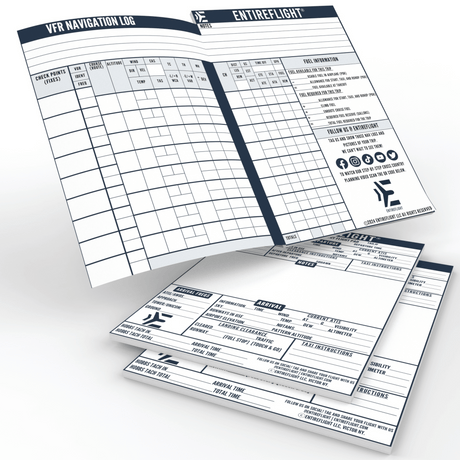
LearnToFly

-
 Introducing Our Exclusive E6B Flight Computer & Sectional Plotter Combo Set
Introducing Our Exclusive E6B Flight Computer & Sectional Plotter Combo SetIntroducing Our Exclusive E6B Flight Computer & Sectional Plotter Combo Set
Discover the ultimate flight navigation toolkit: our E6B Flight Computer & Sectional Plotter Combo Set. Encased in a high-end, giftable box and made from durable plastic, this set equips aviators with...
Samantha White |
-
 Master IFR Flight Planning with Our IFR Flight Notepad: Your Essential Pilot's Tool
Master IFR Flight Planning with Our IFR Flight Notepad: Your Essential Pilot's ToolMaster IFR Flight Planning with Our IFR Flight Notepad: Your Essential Pilot's Tool
Introducing the EntireFlight IFR Flight Notepad, the next step in your journey to becoming a pilot. Perfect companion to your kneeboard & The Venture Flight Bag.
Samantha White |
-
 Radar Vectors: A Guide to Air Traffic Control Navigation
Radar Vectors: A Guide to Air Traffic Control NavigationRadar Vectors: A Guide to Air Traffic Control Navigation
When flying, air traffic control (ATC) plays a crucial role in ensuring the safety of all aircraft in the airspace. One of the tools that ATC uses to guide aircraft is radar, which...
Zachary Franklin |
-
 Age is Just a Number: A Late Bloomer's Guide to Starting Flight Training Later in Life
Age is Just a Number: A Late Bloomer's Guide to Starting Flight Training Later in LifeAge is Just a Number: A Late Bloomer's Guide to Starting Flight Training Later in Life
Starting flight training later in life can be a daunting but exciting experience. Whether you have always dreamed of becoming a pilot, or you are looking for a new challenge...
Zachary Franklin |
-
 High Wing vs Low Wing Aircraft: Comparing Pros and Cons
High Wing vs Low Wing Aircraft: Comparing Pros and ConsHigh Wing vs Low Wing Aircraft: Comparing Pros and Cons
When it comes to aircraft design, one of the most fundamental decisions is whether to use a high-wing or low-wing configuration. In a high wing aircraft, the wings are mounted on top...
Zachary Franklin |
-
 How to Schedule Your FAA Written Exam: Step-by-Step Guide for Aspiring Pilots
How to Schedule Your FAA Written Exam: Step-by-Step Guide for Aspiring PilotsHow to Schedule Your FAA Written Exam: Step-by-Step Guide for Aspiring Pilots
To schedule your FAA written exam, you will need to follow a few simple steps. First, you will need to create an account on the FAA's Integrated Airman Certification and Rating...
Zachary Franklin |
-
 How Much Does Gliding Cost? A Clear Breakdown of Expenses
How Much Does Gliding Cost? A Clear Breakdown of ExpensesHow Much Does Gliding Cost? A Clear Breakdown of Expenses
Gliding, also known as soaring, is a thrilling and unique way to experience the freedom of flight. Unlike traditional powered aircraft, gliders rely solely on the natural forces of wind and...
Zachary Franklin |
-
 How Much Do Airplanes Weigh? Detailed Guide to Aircraft Weight and Its Importance
How Much Do Airplanes Weigh? Detailed Guide to Aircraft Weight and Its ImportanceHow Much Do Airplanes Weigh? Detailed Guide to Aircraft Weight and Its Importance
When you board an airplane, have you ever wondered how much it weighs? It's a valid question, considering the amount of weight that an airplane must carry and the fact...
Zachary Franklin |
-
 How Long Does It Take to Get a Private Pilot's License? Timelines, Steps, and Expectations
How Long Does It Take to Get a Private Pilot's License? Timelines, Steps, and ExpectationsHow Long Does It Take to Get a Private Pilot's License? Timelines, Steps, and Expectations
If you're interested in getting your private pilot's license, one of the first things you may be wondering is how long it will take to complete the necessary training. The...
Zachary Franklin |
-
 How Do Planes Land? Step-by-Step Landing Process Explained
How Do Planes Land? Step-by-Step Landing Process ExplainedHow Do Planes Land? Step-by-Step Landing Process Explained
When you board a plane, you might not think about how it's going to land. It's easy to take for granted that the pilot will safely guide the aircraft to...
Zachary Franklin |
-
 Class E Airspace: What Pilots Need to Know
Class E Airspace: What Pilots Need to KnowClass E Airspace: What Pilots Need to Know
Class E airspace is a type of airspace in the United States that is designated for controlled airspace. It is located above the surface of the earth and extends upward...
Zachary Franklin |
-
 Pilot's Guide to Isolated and Scattered Thunderstorms: Tips and Strategies for Safer Flying
Pilot's Guide to Isolated and Scattered Thunderstorms: Tips and Strategies for Safer FlyingPilot's Guide to Isolated and Scattered Thunderstorms: Tips and Strategies for Safer Flying
If you're a pilot, you know that thunderstorms can be one of the most challenging weather conditions to navigate through. Isolated and scattered thunderstorms can be particularly tricky to fly through,...
Zachary Franklin |



























